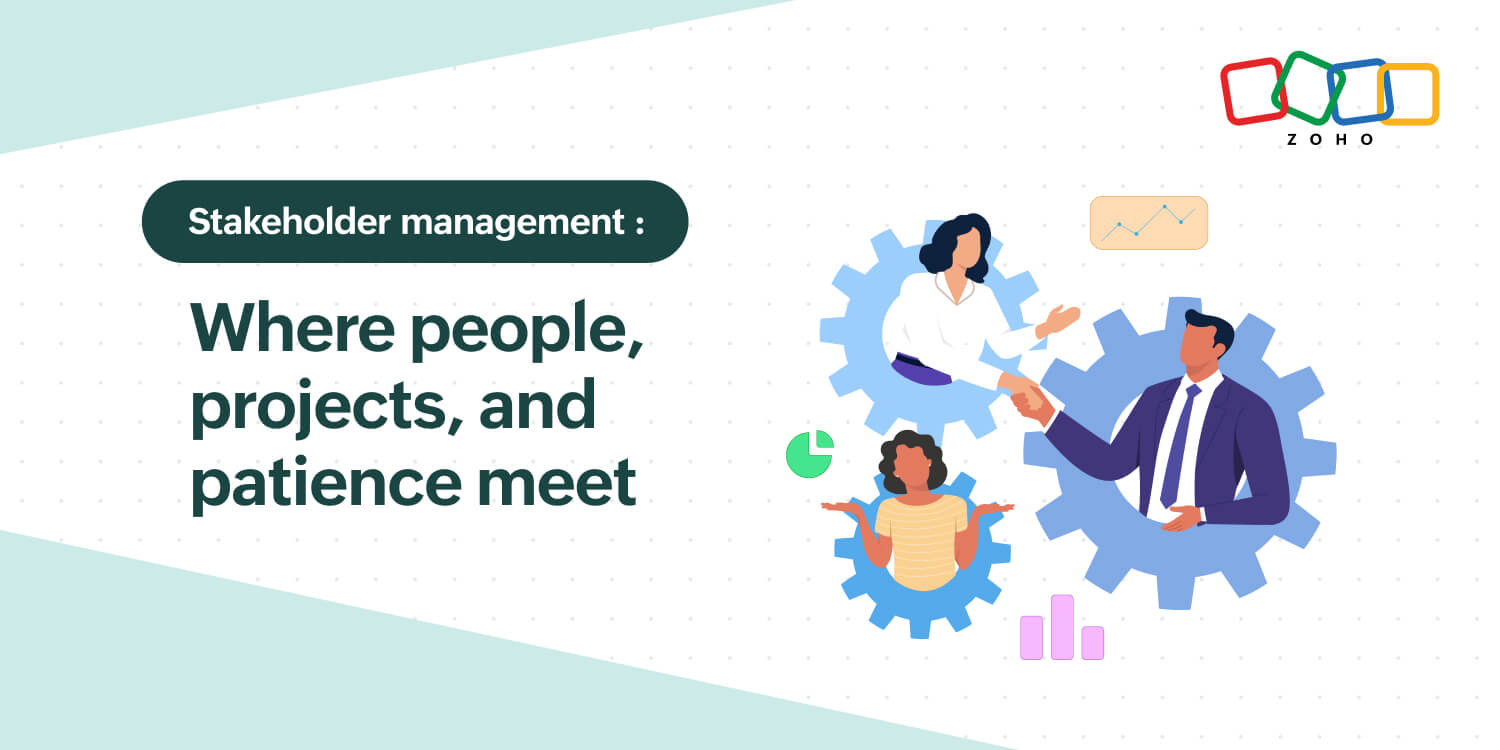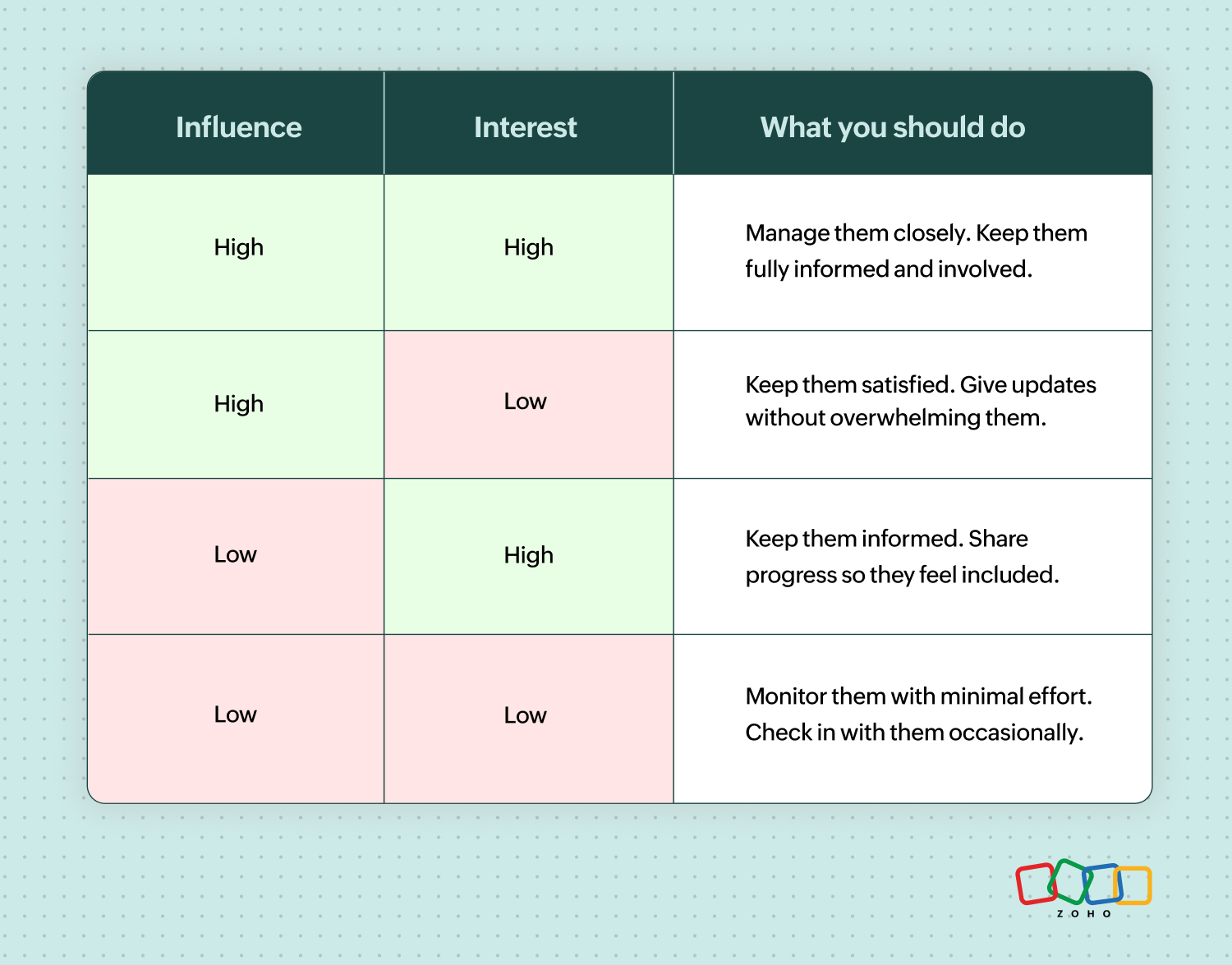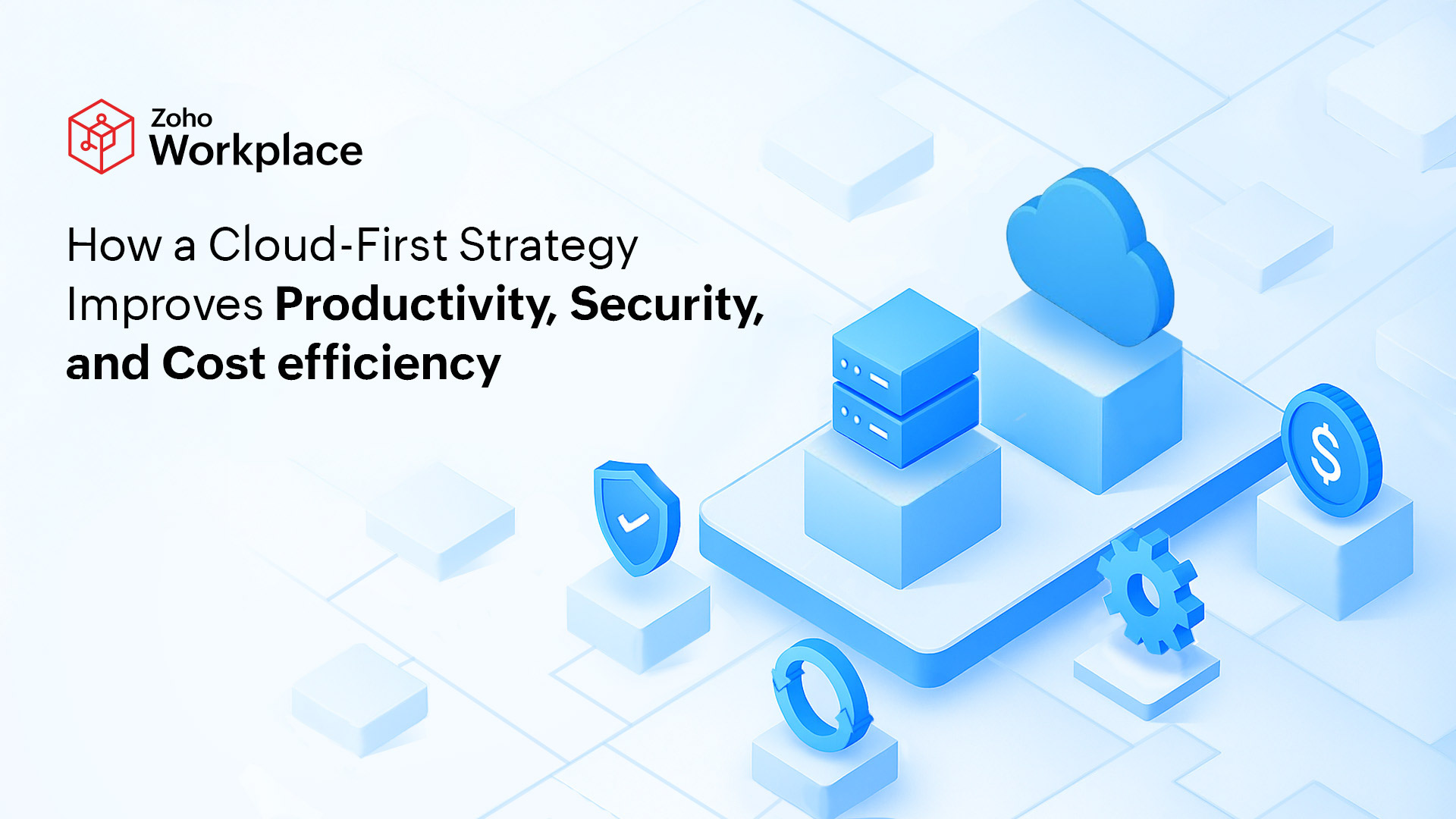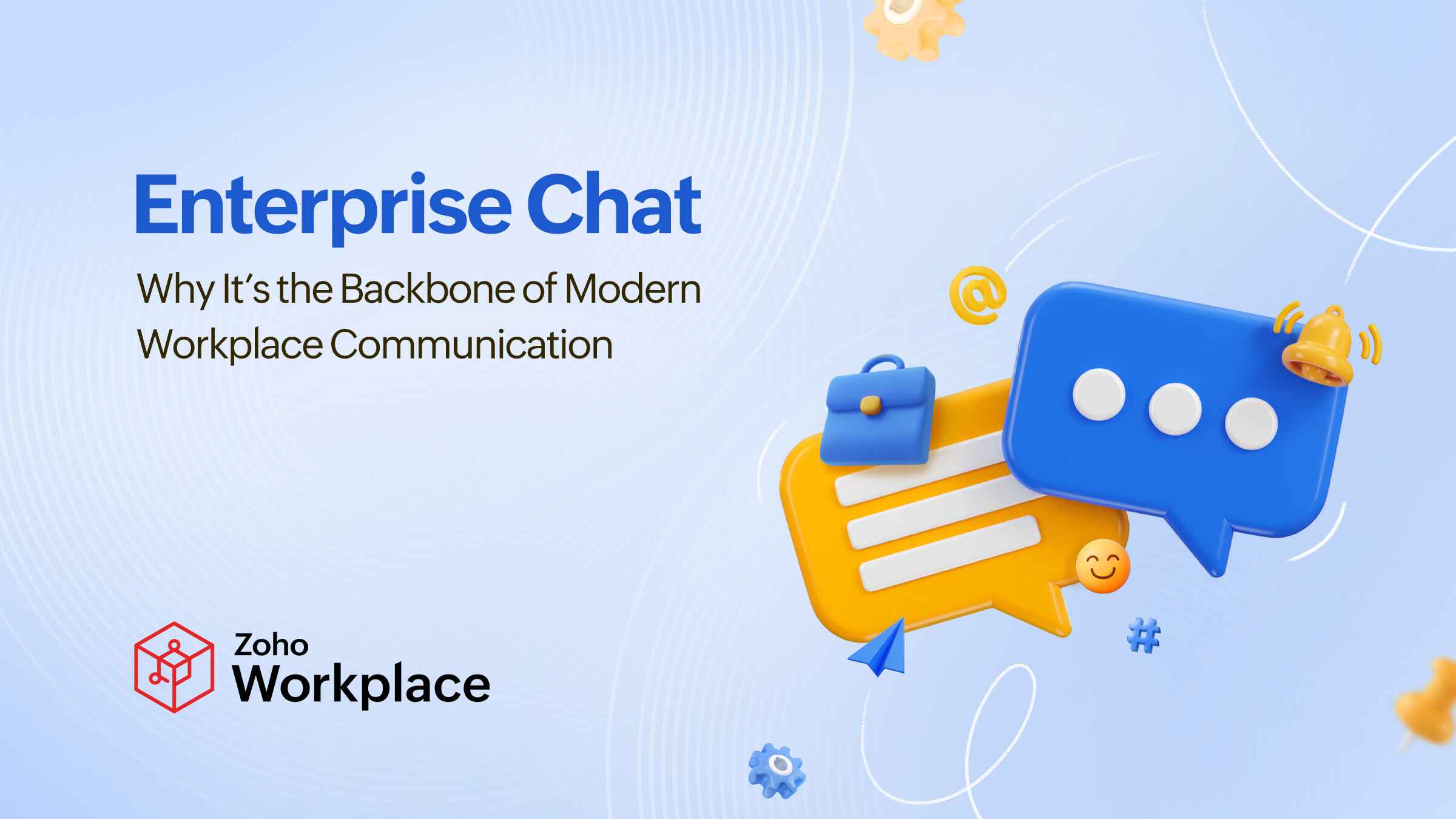- HOME
- All Products
- Collaboration
- Stakeholder management: Where people, projects, and patience meet
Stakeholder management: Where people, projects, and patience meet
- Published : October 23, 2025
- Last Updated : October 24, 2025
- 163 Views
- 8 Min Read
You’re leading a project that’s meant to transform how your team works. The plan is ready, the Gantt chart looks beautiful, and the team seems prepared for anything. For a while, everything moves like clockwork.
Then it begins. The finance head asks why 40% of the budget is already gone. The marketing team suggests a rebrand halfway through. Your biggest client suddenly decides they would like weekly progress calls "just to stay updated."
At this point, your project plan isn’t the problem. People are.

Welcome to the world of stakeholder management. Success here depends less on technical expertise and more on how well you manage expectations, communicate clearly, and keep everyone moving in the same direction. It’s part strategy, part psychology, and a generous amount of patience.
What is stakeholder management?
At its core, stakeholder management is about understanding people. Every project, no matter how technical or straightforward, has one thing in common—people who care about the outcome. Some are deeply invested, others are just curious, and a few are waiting to see what goes wrong first.
A stakeholder is anyone who can influence or be affected by your project. That includes your team, your manager, your client, the end user, and sometimes even people who weren’t supposed to be involved but somehow always are.
Stakeholder management is the process of identifying these people, understanding what they want, and communicating with them in a way that keeps your project on track. It’s not about keeping everyone happy. That’s impossible. It’s about keeping everyone informed, engaged, and confident that the project is moving in the right direction.
When you manage stakeholders well, conversations become easier, decisions happen faster, and problems get solved before they get out of hand. It’s the quiet skill that turns a group of individuals with different priorities into a team working toward a shared goal.
Different types of stakeholders
Once you start a project, you quickly realize that not all stakeholders are the same. Some sit right beside you and make daily decisions. Others are far removed from your meetings but hold the power to change everything with a single email. Understanding who’s who helps you decide how much attention and communication each one needs.
Broadly, stakeholders are categorized as internal and external.
Internal stakeholders
These are the people inside your organization who have a direct role or interest in your project. They include your team members, department heads, senior managers, and even executives who want updates but may never attend a meeting.
They care about how the project fits into the company’s larger goals, how resources are used, and whether deadlines are realistic. Managing internal stakeholders often means keeping communication clear, progress visible, and surprises minimal.
External stakeholders
External stakeholders are the people outside your organization who are affected by or can influence your project. They could be clients, customers, vendors, investors, government agencies, or even the public.
They usually care about results—whether the project delivers what was promised, on time, and within budget. Managing external stakeholders requires a mix of professionalism and empathy. You need to keep them informed without overwhelming them, and confident without over-promising.
While the categories sound simple, real-life projects often blur the lines. A client can act like an internal partner. A vendor might become an unofficial advisor. The key is to recognize their influence early and build relationships that make collaboration easier.
The stakeholder matrix
Once you’ve identified your stakeholders, the next question is: How do you decide who needs constant attention and who just needs a polite update once in a while? That’s where the Stakeholder Matrix comes in.
Think of it as a simple map that helps you organize your stakeholders based on two factors—influence and interest. Influence refers to how much power someone has over your project, and interest refers to how much they care about its outcome.

This simple framework can save you from unnecessary chaos. It reminds you that not everyone needs a daily email or meeting invite. Some people want details; others just want reassurance that things are under control.
For example, your senior management might fall into the “high influence, low interest” box. They have power but limited time, so short summaries work best. On the other hand, your project team and key clients are usually “high influence, high interest.” They need deeper involvement and frequent updates.
By mapping stakeholders this way, you can plan your communication more strategically and avoid spending your time where it doesn’t make a real difference. The matrix doesn’t just organize people; it gives you clarity on how to work with them.
Principles of stakeholder management
Good stakeholder management isn’t just luck. It comes down to a few simple but powerful principles that help you handle people, priorities, and pressure with ease.
Know your stakeholders
You cannot manage what you do not understand. Start by identifying everyone who’s connected to your project, even in the smallest way. Write their names down, note their roles, and think about how the project affects them. This gives you a clear picture of who matters most and who needs how much and what kind of attention.
Understand their expectations
Every stakeholder has something they care about—deadlines, budgets, recognition, control, or just peace of mind. When you know what drives them, it becomes easier to shape your communication and decisions around what they value most.
Communicate early and often
Silence is the enemy of trust. Keep people in the loop before they have to ask for updates. Even a short message can prevent unnecessary confusion or frustration. When in doubt, share.
Manage expectations honestly
You won’t always be able to deliver everything everyone wants. The key is to set realistic boundaries from the start and be honest about what’s possible. Stakeholders appreciate clarity far more than last-minute surprises.
When you follow these principles, you move from simply managing stakeholders to leading them, and guiding everyone toward the same outcome while keeping communication open and relationships strong.
Build relationships, not just reports
Stakeholder management isn’t only about progress updates and spreadsheets. It’s also about people. A friendly conversation, a quick check-in, or remembering small details can go a long way in building trust. People support those they feel connected to.
Stay flexible
Projects change. Stakeholders change. Priorities shift. The best project managers adapt quickly without losing sight of the goal. They read the room, adjust their plans, and keep the momentum going.
Skills required for effective stakeholder management
If managing stakeholders feels like juggling while walking a tightrope, that’s because it often is. But with the right mix of skills, it becomes much easier to balance competing interests and keep everyone moving in the same direction.
Here are the key skills every good project manager needs.
Communication
This is the backbone of stakeholder management. It’s not just about talking—it’s about listening, understanding, and adapting your message to suit different audiences. Some stakeholders prefer detailed reports, while others just want quick updates. Knowing the difference saves time and avoids confusion.
Empathy
Every stakeholder has pressures and priorities you may not see. Empathy helps you understand where people are coming from and why they react a certain way. It turns disagreements into discussions and builds long-term trust.
Negotiation
You will often find yourself in the middle of conflicting demands. Negotiation is the art of finding balance—making sure everyone gets something they value without the project losing focus.
Conflict resolution
Disagreements are inevitable. The skill lies in spotting tension early and addressing it calmly before it grows. The goal isn’t to win arguments but to keep collaboration alive.
Influence
Sometimes you have no authority over a stakeholder, yet you still need their support. Influence comes from credibility, consistency, and how you make others feel heard. It’s subtle but powerful.
Organization
From meeting notes to status reports, good organization ensures that no promise or request slips through the cracks. It also gives stakeholders confidence that the project is in steady hands.
Emotional intelligence
This ties everything together. Being aware of your own emotions and responding thoughtfully to others can make the difference between a tense meeting and a productive one.
When these skills come together, managing stakeholders stops feeling like constant damage control and starts feeling like genuine leadership.
Examples of stakeholder management
Sometimes the best way to understand stakeholder management is through real-life scenarios. Let’s look at a couple of examples that show how it works in practice.
Example 1: The product launch
A startup was preparing to launch a new app. There were five key groups to keep in mind: the investors, the marketing team, the engineers, the support staff, and a small group of early customers. Each had different priorities. Investors wanted to see progress without too many details, the engineers needed clear specs, and the customers just wanted to feel involved.
The project manager decided on a tailored approach. Investors got concise monthly updates. Engineers had weekly syncs. Customers were involved in short surveys and beta tests. By paying attention to what each group needed, the launch went smoothly, and everyone felt included without being overwhelmed.
Example 2: The infrastructure project
In a city infrastructure project, local residents were initially opposed to a new community center. Instead of ignoring them, the project team held open forums, listened to concerns, and adjusted plans to reduce disruption. They also kept residents updated throughout the construction.
By managing expectations early and showing that their voices mattered, the team turned opponents into supporters. The project continued without major protests, and residents even became advocates for the center once it opened.
Example 3: Internal change management
A company was implementing a new internal tool to replace an old system. Many employees were skeptical, worried about learning curves and extra work. The project manager scheduled small group sessions, shared easy guides, and invited feedback at every stage.
Employees felt heard and supported, adoption happened faster, and management saw fewer complaints than expected. By actively managing internal stakeholders, what could have been a tense rollout became a collaborative effort.
Wrapping up..
Stakeholder management isn’t just another line on your project checklist. It’s one of those behind-the-scenes skills that can quietly make or break a project.
All the principles, skills, matrices, and examples we’ve talked about have the same purpose: helping you turn potential roadblocks into partners. When you manage your stakeholders well, communication flows more smoothly, decisions happen faster, and projects run with fewer surprises.
Think of it like every stakeholder is a piece of the puzzle. Ignore even one, and the picture feels incomplete. If you ignore even one, the picture never comes together. But when you listen, adapt, and involve the right people in the right way, suddenly the pieces start fitting, and the project comes to life.
So the next time your inbox overflows with “urgent” emails or your calendar is jam-packed with meetings, take a moment to breathe. You’re not just tracking tasks. You’re guiding people. And that’s what makes a project succeed.
 Anjana Balaji
Anjana BalajiAnjana is a passionate marketer who works for Zoho. Apart from the crazy movie buff that she is, she's also a trained musician and a creative home-chef!


